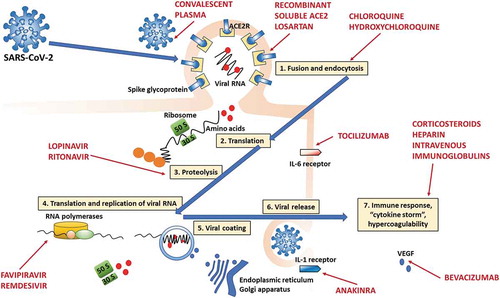Figures & data
Figure 1. Main drugs tested to date in SARS-CoV-2 infection and their potential mechanisms and sites of action in the viral infection and replication cycle. 1. SARS-CoV-2 enters cells by binding the ACE2 receptor, with subsequent fusion and endocytosis (recombinant soluble ACE2 and losartan would act at this level). 2. Viral RNA is released, and transduction begins in the ribosome. 3. This is followed by proteolysis (may be inhibited by lopinavir/ritonavir), which in turn is followed by translation and replication (RNA polymerases; may be inhibited by favipiravir and remdesivir). 5. Then, the ribosome synthesizes nucleocapsid proteins, which will encase RNA, and the viral envelope is assembled with the aid of the endoplasmic reticulum and Golgi apparatus. The now-complete virions are released, ready to infect other cells. 7. In parallel, a local and systemic immune response is now activated, and hypercoagulability ensues (modulated by corticosteroids and heparin). The IL-6 receptor can be inhibited by tocilizumab, and the IL-1 receptor, by anakinra. Bevacizumab acts by inhibiting vascular endothelial growth factor (VEGF). Convalescent plasma reduces viral load.

Table 1. Main proposed drugs for the management of COVID-19 patients.
